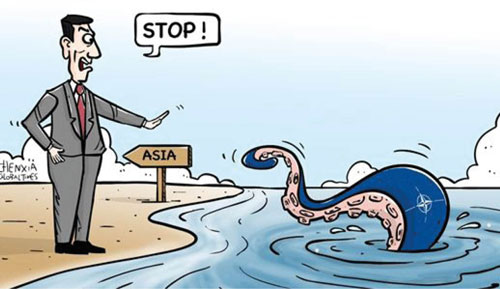NATO Secretary General Jens Stoltenberg concluded his trip to Asia last week, which is widely seen as a trip helping Washington rope in Tokyo and Seoul by hyping up the so-called threats from China and Russia.
Through the trip, NATO wants its close partners in the region to completely take side with the bloc in terms of the ongoing Ukraine crisis. This notably includes South Korea, which does not satisfy the US, as the country’s stance in this regard seems ambiguous and the Russia-Ukraine crisis has fueled a rapid growth in South Korea’s arms exports as countries supporting Kiev turn to Seoul to replenish their supplies. NATO hopes Seoul and Tokyo and can provide more military aid to Ukraine, to display its position – at daggers drawn with Russia.
Another purpose of Stoltenberg’s Asia trip is to coordinate the US’ strategy to contain China. The NATO has listed China as one of its strategic priorities for next decade, saying Beijing’s policies challenge its security. This is actually due to the US’ global strategy targeting China as its top rival. After all, the bloc is merely a military tool of Washington.
Washington has two paths to achieve the bloc’s expansion into to the Asia Pacific and even the rest of the world, although it is difficult to directly absorb Asian countries into the North Atlantic military alliance, one means is to create a new military bloc by expanding AUKUS, a trilateral agreement between Australia, the UK, and the US, attracting more countries to join the pact.
Another is to absorb more regional countries to the NATO Plus arrangement. NATO’s strategy of expansion to the Indo-Pacific via the NATO Plus approach can be seen as an Octopus strategy. Although the bloc itself will not directly engage in regional affairs, its tentacles can.
Today, apart from Japan and South Korea, New Zealand and Australia has already been absorbed into this arrangement. The US is seeking to add India to the plan. That is to say that the military alliance’s tentacles have extended into the Indo-Pacific region, coinciding with the US’ Indo-Pacific Strategy.
As this strategy mainly targets China, NATO’s cooperation with Japan and South Korea can help turn its strategic determination into action. When the bloc is tied up with the Ukraine crisis in Europe, it believes that it will be easier to exploit the two NATO Plus countries, especially China’s close neighboring countries, to stir up tensions in the Indo-Pacific.
As for whether the “Ukrainian model” will repeat itself in the Indo-Pacific, the key lies in whether there is a country in Asia willing to follow the US’ lead like Ukraine, playing the role as a proxy to sustain the US’ hegemony and contain China.
Among all Asian countries, Japan is a special case. In both World War I and II, Japan was a country advocating power politics, and its aggression in the past had brought countless suffering to regional countries. The country also considers itself a Western country. China and Japan has not only geopolitical tension, but also historical conflict. All these will be fully taken advantage of by Washington. Japan may become a “Ukraine of Asia” if continuing follow the US’ strategy to contain China closely.
Most of the rest of the Asian countries, including China, have historical memories of being invaded. And they understand China’s intent in pursuing strength and autonomy as well as many other stances and practices. As a result, as long as China clarifies its purpose of its policy and moves, it is believed that the majority of regional countries, will not follow the US’ lead, at least they will not take side between Beijing and Washington.









